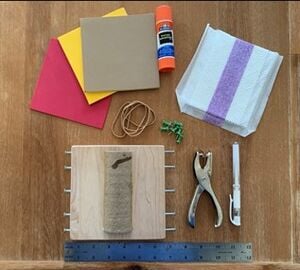The physical simulator is a low-cost, easily-assembled, and locally-sourced platform for the self-directed training and mastery of reconstructive techniques.
Background[edit | edit source]
It was designed using common materials that are widely available, inexpensive, and quickly assembled using just a hammer or screwdriver and glue. Requiring neither electricity nor internet, it’s both portable and universally accessible. Most importantly, the physical simulator serves as a high-fidelity model of the composite tissue substrate on which local flap surgery is based with anatomic representations for epidermis, dermis, subcutaneous tissue, and fascia. Using just a marking pen, scalpel, forceps, hemostat, and needle driver, the user is able to physically perform all of the maneuvers constituting flap design, elevation, and inset in nearly the same manner required of an in vivo model. Furthermore, our singular physical simulator is adaptable to a variety of local flap surgeries without requiring any additional components or modifications. This ensures that the simulator is translatable throughout the continuum of local flap surgery and affords trainees with the ability to practice a wide array of local flap procedures.
This page further details the list of items, tools, and costs associated with assembly, installation, operation, and maintenance. No specific skills are background are required to build this simulator given that there is no electrical wiring, circuit construction, computer programming, or other skill-intensive aspect to simulator construction. Currently, other skin flap simulators on the market cost more than $100 USD and up to $1,000 USD to purchase. Internationally purchased items have the added shipping costs which in many cases can be just as expensive as the primary purchase. Furthermore, having to purchase a simulator means that a user would potentially have to wait weeks to months before the purchased simulator arrives, especially in more remote regions of the world where our intended end users are located. This means that our locally sourced simulator confers significant cost and time savings compared to any other flap surgery simulator that is publicly available. In fact, our volunteers in South Africa, Cameroon, and Rwanda have confirmed that the total cost for construction of our physical simulator no greater than 5 USD.
Tools & Materials[edit | edit source]
- Wood Block- 15 cm x 15 cm x 2 cm wood block (at least 2 cm thick to hold screws or nails) that serves as the foundation for the simulator
- Screws, Nails, or Thumbtacks - either screws, nails, or thumbtacks can be used to create the 10 pegs (5 each on opposing sides) which will hold the rubber bands. Different combinations of nails and screws as well as sizes and lengths can be used to create the 10 pegs as long as they can be securely fastened to the wood block to hold tension from the rubber bands
- Cardboard Tube or Cylinder - 12 cm to 15 cm long cardboard cylinder that creates the curved surface to enhance the flap simulation (common sources: toilet paper, gift/wrapping paper, fabric/textile rolls, or paper towel rolls)
- Rubber Bands - Any size rubber bands or similar elastic string that can be used to secure the soft tissue construct to the pegs.
- Foam Fabric - 3 pieces of 12 cm x 12 cm x 2mm foam fabric is needed to create a sandwich of fabric representing the various layers of skin and fascia. Any foam fabric or other elastic fabric with at least a 2 mm thickness can work.
- Layered Cotton Material - A folder piece of or 2 sheets of 12cm x 12cm cotton material/fabric/sheets. This will be placed between 2 foam fabric pieces (representing the dermis and epidermis) and 1 foam fabric piece representing the fascia to create a flap surgery sandwich block (as seen in physical model construction video).
- Glue or Tape - Used to secure cardboard tube to wood block and to attach the different anatomic layers together.
- Screwdriver and/or Hammer - Depending on whether screws or nails were used for the 10 wood block pegs, either a hammer or screwdriver is required. Neither are needed for thumbtacks.
- Hole Puncher - Used to create the 6 holes in the foam fabric. If hole puncher not available then any other tool that can create the 6 holes is adequate such as the tip of a knife or scissors.

